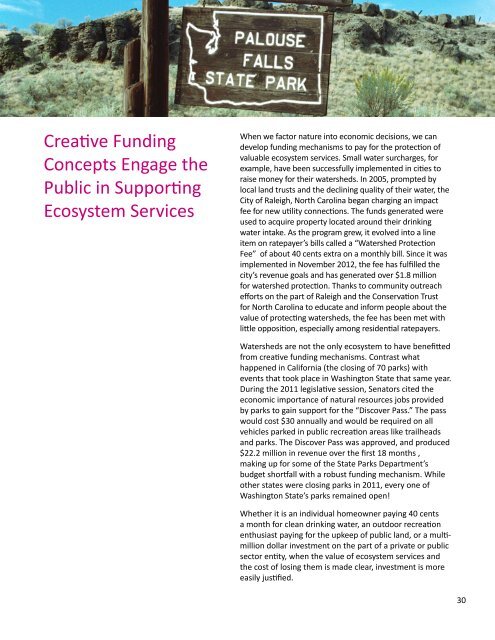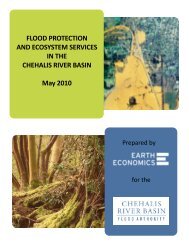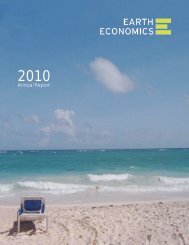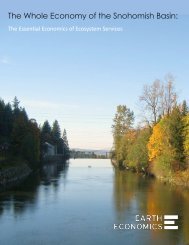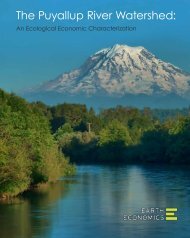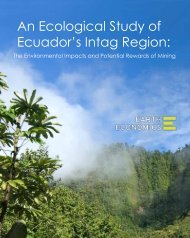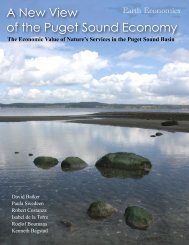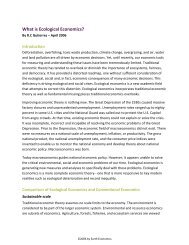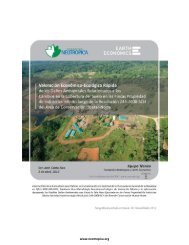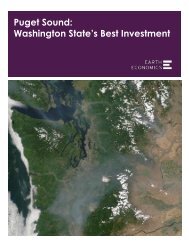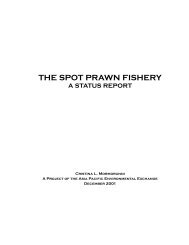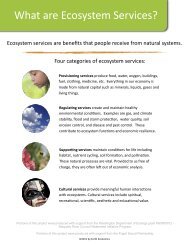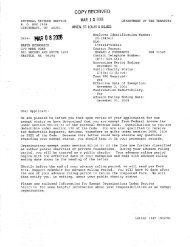A Handbook for Understanding Natural Capital - Earth Economics
A Handbook for Understanding Natural Capital - Earth Economics
A Handbook for Understanding Natural Capital - Earth Economics
You also want an ePaper? Increase the reach of your titles
YUMPU automatically turns print PDFs into web optimized ePapers that Google loves.
Creative Funding<br />
Concepts Engage the<br />
Public in Supporting<br />
Ecosystem Services<br />
When we factor nature into economic decisions, we can<br />
develop funding mechanisms to pay <strong>for</strong> the protection of<br />
valuable ecosystem services. Small water surcharges, <strong>for</strong><br />
example, have been successfully implemented in cities to<br />
raise money <strong>for</strong> their watersheds. In 2005, prompted by<br />
local land trusts and the declining quality of their water, the<br />
City of Raleigh, North Carolina began charging an impact<br />
fee <strong>for</strong> new utility connections. The funds generated were<br />
used to acquire property located around their drinking<br />
water intake. As the program grew, it evolved into a line<br />
item on ratepayer’s bills called a “Watershed Protection<br />
Fee” of about 40 cents extra on a monthly bill. Since it was<br />
implemented in November 2012, the fee has fulfilled the<br />
city’s revenue goals and has generated over $1.8 million<br />
<strong>for</strong> watershed protection. Thanks to community outreach<br />
ef<strong>for</strong>ts on the part of Raleigh and the Conservation Trust<br />
<strong>for</strong> North Carolina to educate and in<strong>for</strong>m people about the<br />
value of protecting watersheds, the fee has been met with<br />
little opposition, especially among residential ratepayers.<br />
Watersheds are not the only ecosystem to have benefitted<br />
from creative funding mechanisms. Contrast what<br />
happened in Cali<strong>for</strong>nia (the closing of 70 parks) with<br />
events that took place in Washington State that same year.<br />
During the 2011 legislative session, Senators cited the<br />
economic importance of natural resources jobs provided<br />
by parks to gain support <strong>for</strong> the “Discover Pass.” The pass<br />
would cost $30 annually and would be required on all<br />
vehicles parked in public recreation areas like trailheads<br />
and parks. The Discover Pass was approved, and produced<br />
$22.2 million in revenue over the first 18 months ,<br />
making up <strong>for</strong> some of the State Parks Department’s<br />
budget shortfall with a robust funding mechanism. While<br />
other states were closing parks in 2011, every one of<br />
Washington State’s parks remained open!<br />
Whether it is an individual homeowner paying 40 cents<br />
a month <strong>for</strong> clean drinking water, an outdoor recreation<br />
enthusiast paying <strong>for</strong> the upkeep of public land, or a multimillion<br />
dollar investment on the part of a private or public<br />
sector entity, when the value of ecosystem services and<br />
the cost of losing them is made clear, investment is more<br />
easily justified.<br />
30


